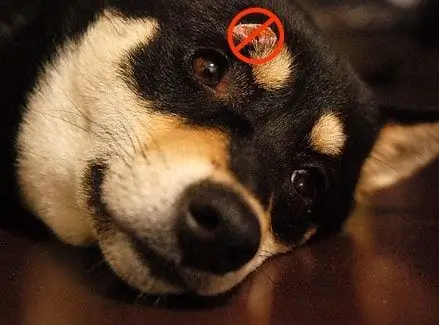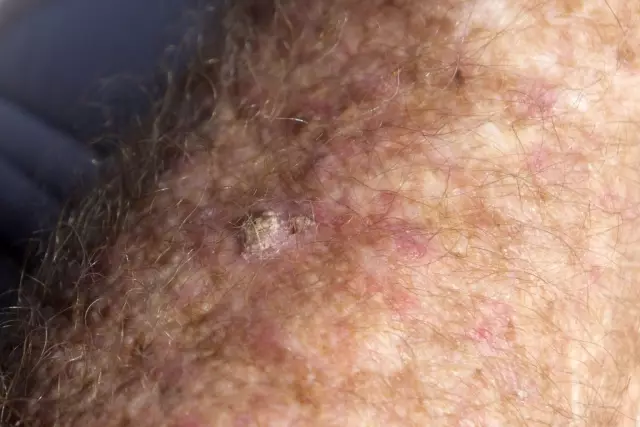
- Συγγραφέας Daisy Haig [email protected].
- Public 2023-12-17 03:07.
- Τελευταία τροποποίηση 2025-01-24 12:35.
Και τα δύο γαλλικά μπουλντόγκ μου υπέφεραν από άσχημο, συχνά φαγούρα και καλοήθεις όγκους που ονομάζουμε ιστιοκύτταρα. Παρόλο που τα ιστιοκύτταρα συνήθως υποχωρούν μετά από δύο έως τρεις μήνες, η αβεβαιότητα της προέλευσης αυτού του όγκου οδηγεί τους περισσότερους κτηνιάτρους να το κόψουν (ή τουλάχιστον μέρος αυτού) για να διασφαλίσουν την καλοσύνη του.
Ένα χειρουργικό χειρουργικό νυστέρι μίας «καλοήθους» μάζας μπορεί να ακούγεται ακραίο για εσάς, αλλά επειδή τα ιστιοκύτταρα μπορεί να είναι ενοχλητικά και τρομακτικά, συχνά υποδεικνύεται χειρουργική επέμβαση.
Ενοχλητικό: Επειδή εμφανίζονται συχνά στο κεφάλι και στα πόδια, μέρη όπου μια τέλεια στρογγυλή, ελκώδης μάζα μπορεί να γδαρθεί ή να γλιστρήσει εύκολα.
Τρομακτικό: Επειδή είναι δύσκολο να καταλάβουμε αν αυτό που μόλις εμφανίστηκε στο δέρμα του σκύλου σας (και συνήθως συμβαίνει γρήγορα) είναι ένας άσχημος όγκος ιστών κυττάρων (ή κάποια άλλη τέτοια μάζα τεράτων)… ή ο πιο εύχρηστος ξάδελφος του, ο ιστιοκύτωμα.
Τρομακτικό: Επειδή είναι δύσκολο να καταλάβουμε αν αυτό που μόλις εμφανίστηκε στο δέρμα του σκύλου σας (και συνήθως συμβαίνει γρήγορα) είναι ένας άσχημος όγκος ιστών κυττάρων (ή κάποια άλλη τέτοια μάζα τεράτων)… ή ο πιο εύχρηστος ξάδελφος του, ο ιστιοκύτωμα.
while young dogs (under three years of age) are more likely to get these, they can happen to dogs of any age. indeed, my older frenchie, sophie sue got one about a year ago. she was nine-not exactly a spring chicken. vincent has had three. and he’s not yet two years old.
some breeds are more predisposed. labrador retrievers and boxers, for example. though frenchies aren’t on the list, perhaps they should be… (perhaps they should be on the list for almost everything if my recent round of healthcare scares is any guide.)
ugly and prominently placed as they typically are, most owners want histiocytomas removed. some vets, however, will counsel owners to either wait a few weeks (especially if the dog is young and statistically less likely to be suffering from a malignant mass) or to have a simple section of it snipped (with a local anesthetic) for histopathological analysis at the pathology lab.
other vets will even take a needle poke at it, though most pathologists find that histiocytomas are not easily disgnosed definitively through this method (cytology).
if the dog is older or the mass is especially annoying to the dog or owner, however, we remove the whole sucker and clean up the mess quickly. unfortunately, though, this approach is more costly and usually requires general anesthesia. it’s nonetheless the approach i take for more than half of these tumors…better to be safe than sorry, right?
still, most owners need to know they have a choice. the nervous nellies among you (like me) are less likely to want to stare at a mass for a couple of months to see if it simply goes away. the rational or more anesthetically cautious, however, are justified in waiting-as long as their dog is young and/or hasn’t suffered from malignant masses in the past.
whatever choice you make, consider histiocytomas an excellent foray into the world of skin tumors. it’s like a warm-up for what’s likely to come as your dog ages. and it’s not all bad. look on the bright side: curing cancer is sometimes just a scalpel slice away.
Συνιστάται:
Πώς να σταματήσετε με ασφάλεια μια πάλη σκύλου Πώς να αποτρέψετε μια πάλη σκύλου

Το να επιτρέπεται στα σκυλιά να παίζουν μαζί δεν είναι χωρίς κίνδυνο. Ο σκύλος, η κακή επικοινωνία, το να τρέχεις στο «λάθος» σκύλο και η απλή παλιά κακή τύχη μπορεί να οδηγήσουν σε μάχη για σκύλους. Το να γνωρίζετε τι πρέπει να κάνετε πριν, κατά τη διάρκεια και μετά την καταπολέμηση του σκύλου είναι ο καλύτερος τρόπος για να ελαχιστοποιήσετε τους τραυματισμούς. Μάθε περισσότερα
Αιμαγγειοσάρκωμα ή καλοήθης όγκος - Θεραπεία του κατοικίδιου ζώου σας για καρκινικούς όγκους

Όταν δεν υπάρχει τρόπος να γνωρίζουμε εάν ο όγκος του κατοικίδιου ζώου σας είναι καλοήθης ή κακοήθης, πώς αποφασίζετε εάν θα επιτρέψετε ή όχι ιατρική θεραπεία για τον όγκο
Kennel Cough: Μια σε βάθος εμφάνιση

Μια εις βάθος ματιά σε αυτήν την μάλλον ασυνήθιστη αλλά διαδεδομένη ασθένεια
Όγκος λιπαρών ιστών (καλοήθης) σε γάτες

Το διηθητικό λιπόμα είναι ένας διεισδυτικός, καλοήθης όγκος που αποτελείται από λιπώδη ιστό, μια παραλλαγή που δεν μεταστατώνεται (εξαπλώνεται), αλλά είναι γνωστό ότι διεισδύει στους μαλακούς ιστούς, ιδίως στους μύες, αλλά επίσης περιλαμβάνει και τις περιτονίες (το συστατικό μαλακού ιστού του συνδετικού ιστός), τένοντες, νεύρα, αιμοφόρα αγγεία, σιελογόνους αδένες, λεμφαδένες, κάψουλες άρθρωσης και περιστασιακά τα οστά
Όγκος λιπαρών ιστών (καλοήθης) σε σκύλους

Το διηθητικό λιπόωμα είναι ένας παραλλαγμένος όγκος που δεν μεταστατώνεται (εξαπλώνεται), αλλά είναι γνωστό ότι διεισδύει στους μαλακούς ιστούς, ιδίως στους μυς. Είναι ένας επεμβατικός, καλοήθης όγκος που αποτελείται από λιπώδη ιστό και ενώ είναι γνωστός κυρίως για τη διείσδυσή του σε μυϊκούς ιστούς, βρίσκεται επίσης συνήθως στη περιτονία (το συστατικό μαλακού ιστού του συστήματος συνδετικού ιστού), τένοντες, νεύρα, αίμα αγγεία, σιελογόνους αδένες, λεμφαδένες, κάψουλες άρθρωσης και περιστασιακά τα οστά
